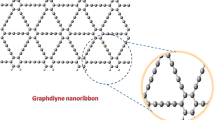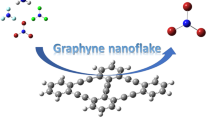Abstract
Density functional theory-based first-principles investigation is performed on pristine and mono vacancy induced GaAs nanoribbons to detect the presence of three volatile organic compounds (VOCs), aniline, isoprene and o-toluidine, which will aid in sensing lung cancer. The study has shown that pristine nanoribbon senses all three analytes. For the pristine structure, we observe decent adsorbing parameters and the bandgap widens after the adsorption of analytes. However, the introduction of the carrier traps induced by defect causes deep energy wells that vary the electrical properties as indicated in the bandgap analysis of GaAs, wherein adsorption of aniline and o-toluidine reduces the bandgap to 0 eV, making the structure highly conductive in nature. The adsorption energies of defect-induced nanoribbon are more as compared with the pristine counterpart. Nonetheless, the introduction of defects has improved the sensitivity further.
Graphical abstract
















Similar content being viewed by others
Data availability
Not applicable.
Code availability
Not applicable.
References
L. Dominioni, A. Imperatori, F. Rovera, A. Ochetti, G. Torrigiotti, M. Paolucci, Stage I nonsmall cell lung carcinoma, Cancer 89:2334.
Wan Q, Xu Y, Xiao H (2018) Exhaled gas detection by Ir-doped CNT for primary diagnosis of lung cancer. AIP Adv 8:105128. https://doi.org/10.1063/1.5050435
Pauling L, Robinson AB, Teranishi R, Cary P (1971) Quantitative analysis of urine vapor and breath by gas liquid partition chromatography. prOceedings of the National Academy of Sciences 68:2374. https://doi.org/10.1073/pnas.68.10.2374
Hoa LT, Tien HN, Luan VH, Chung JS, Hur SH (2013) Fabrication of a novel 2D-graphene/2D-NiO nanosheet-based hybrid nanostructure and its use in highly sensitive NO2 sensors. Sens Actuators, B Chem 185:701. https://doi.org/10.1016/j.snb.2013.05.050
Chen X-P, Wang L-M, Sun X, Meng R-S, Xiao J, Ye H-Y, Zhang G-Q (2017) Sulfur dioxide and nitrogen dioxide gas sensor based on arsenene: a first-principle study. IEEE Electron Device Lett 38:661. https://doi.org/10.1109/led.2017.2684239
Srimathi U, Nagarajan V, Chandiramouli R (2019) Germanane nanosheet as a novel biosensor for liver cirrhosis based on adsorption of biomarker volatiles – a DFT study. Appl Surf Sci 475:990. https://doi.org/10.1016/j.apsusc.2019.01.008
Aragay G, Pino F, Merkoçi A (2012) Nanomaterials for sensing and destroying pesticides. Chem Rev 112(10):5317–5338. https://doi.org/10.1021/cr300020c
Biju V (2014) Chemical modifications and bioconjugate reactions of nanomaterials for sensing, imaging, drug delivery and therapy. Chem Soc Rev 43(3):744–764. https://doi.org/10.1039/c3cs60273g
Demchenko AP, Dekaliuk MO (2013) Novel fluorescent carbonic nanomaterials for sensing and imaging. Methods and Applications in Fluorescence 1(4):042001. https://doi.org/10.1088/2050-6120/1/4/042001
Etienne M, Goux A, Sibottier E, Walcarius A (2009) Oriented mesoporous organosilica films on electrode: a new class of nanomaterials for sensing. J Nanosci Nanotechnol 9(4):2398–2406. https://doi.org/10.1166/jnn.2009.se39
Yoon HJ, Jun DH, Yang JH, Zhou Z, Yang SS, Cheng MM-C (2011) Carbon dioxide gas sensor using a graphene sheet. Sens Actuators, B Chem 157:310. https://doi.org/10.1016/j.snb.2011.03.035
Jeong HY, Lee D-S, Choi HK, Lee DH, Kim J-E, Lee JY, Lee W-J, Kim S-O, Choi S-Y (2010) Flexible room-temperature NO2 gas sensors based on carbon nanotubes/reduced graphene hybrid films. Appl Phys Lett 96(21):213105. https://doi.org/10.1063/1.3432446
Zheng Z, Wang H (2019) Different elements doped graphene sensor for CO2 greenhouse gases detection: the DFT study. Chem Phys Lett. https://doi.org/10.1016/j.cplett.2019.02.024
Shokuhi RA, Esfahanian M, Maleki S, Gharati G (2016) Application of carbon nanostructures toward SO2 and SO3adsorption: a comparison between pristine graphene and N doped graphene by DFT calculations. J Sulfur Chem 37(2):176–188. https://doi.org/10.1080/17415993.2015.1116536
Rad AS, Shabestari SS, Mohseni S, Aghouzi SA (2016) Study on the adsorption properties of O 3, SO 2, and SO 3 on B-doped graphene using DFT calculations. J Solid State Chem 237:204–210. https://doi.org/10.1016/j.jssc.2016.02.023
Walia GK, Randhawa DKK (2017) Electronic and transport properties of silicene-based ammonia nanosensors: an ab initio study. Struct Chem 29:257. https://doi.org/10.1007/s11224-017-1025-9
Walia GK, Randhawa DKK (2018) First-principles investigation on defect-induced silicene nanoribbons — a superior media for sensing NH 3, NO 2 and NO gas molecules. Surf Sci 670:33. https://doi.org/10.1016/j.susc.2017.12.013
Walia, G. K., & Randhawa D. K. K. (2018). Adsorption and dissociation of sulfur-based toxic gas molecules on silicene nanoribbons: a quest for high-performance gas sensors and catalysts. Journal of Molecular Modeling, 24(4).https://doi.org/10.1007/s00894-018-3631-x
Walia GK, Randhawa DKK (2018) Gas-sensing properties of armchair silicene nanoribbons towards carbon-based gases with single-molecule resolution. Struct Chem 29:1893. https://doi.org/10.1007/s11224-018-1170-9
Walia GK, Randhawa DKK (2018) Density-functional study of hydrogen cyanide adsorption on silicene nanoribbons. J Mol Model 24:242. https://doi.org/10.1007/s00894-018-3782-9
Sadeghi H, Bailey S, Lambert CJ (2014) Silicene-based DNA nucleobase sensing. Appl Phys Lett 104(10):103104. https://doi.org/10.1063/1.4868123
Tarun, T., Randhawa, D. K. K., Singh, P., Choudhary, B. C., Walia, G. K., & Kaur, N. (2020). Analysis of uric acid adsorption on armchair silicene nanoribbons: a DFT study. Journal of Molecular Modeling, 26(3).https://doi.org/10.1007/s00894-020-4313-z
Singh, P., Randhawa, D. K. K., Tarun, Choudhary, B. C., Walia, G. K., & Kaur, N. (2019). First principles investigation on armchair zinc oxide nanoribbons as uric acid sensors. Journal of Molecular Modeling, 26(1).https://doi.org/10.1007/s00894-019-4243-9
Kou L, Li C, Zhang Z, Guo W (2010) Tuning magnetism in zigzag ZnO nanoribbons by transverse electric fields. ACS Nano 4(4):2124–2128. https://doi.org/10.1021/nn901552b
Topsakal, M., Cahangirov, S., Bekaroglu, E., & Ciraci, S. (2009). First-principles study of zinc oxide honeycomb structures. Physical Review B, 80(23).https://doi.org/10.1103/physrevb.80.235119
Xia W, Hu W, Li Z, Yang J (2014) A first-principles study of gas adsorption on germanene. Phys Chem Chem Phys 16:22495. https://doi.org/10.1039/c4cp03292f
Monshi MM, Aghaei SM, Calizo I (2017) Doping and defect-induced germanene: a superior media for sensing H 2 S, SO 2, and CO 2 gas molecules. Surf Sci 665:96. https://doi.org/10.1016/j.susc.2017.08.012
Nagarajan V, Chandiramouli R (2017) NO 2 adsorption behaviour on germanene nanosheet – a first-principles investigation. Superlattices Microstruct 101:160. https://doi.org/10.1016/j.spmi.2016.11.032
Nagarajan V, Chandiramouli R (2017) CO and NO monitoring using pristine germanene nanosheets: DFT study. J Mol Liq 234:355. https://doi.org/10.1016/j.molliq.2017.03.100
Choi S-J, Kim I-D (2018) Recent developments in 2D nanomaterials for chemiresistive-type gas sensors. Electron Mater Lett 14:221. https://doi.org/10.1007/s13391-018-0044-z
Rozahun I, Bahti T, He G, Ghupur Y, Ablat A, Mamat M (2018) GaAs monolayer: Excellent SHG responses and semi metallic to metallic transition modulated by vacancy effect. Appl Surf Sci 441:401. https://doi.org/10.1016/j.apsusc.2018.02.045
Volovik BV, Kovsh AR, Passenberg W, Kuenzel H, Grote N, Cherkashin NA, Ustinov VM (2001) Optical and structural properties of self-organized InGaAsN/GaAs nanostructures. Semicond Sci Technol 16(3):186–190. https://doi.org/10.1088/0268-1242/16/3/312
Liang D, Huo Y, Kang Y, Wang KX, Gu A, Tan M, Yu Z, Li S, Jia J, Bao X, Wang S, Yao Y, Wong HS, Fan S, Cui Y, Harris JS (2012) Optical absorption enhancement in freestanding gaas thin film nanopyramid arrays. Adv Energy Mater 2(10):1254–1260. https://doi.org/10.1002/aenm.201200022
Rouzhahong, Y., Wushuer, M., Mamat, M., Wang, Q., & Wang, Q. (2020). First principles calculation for photocatalytic activity of GaAs Monolayer. Scientific Reports, 10(1).https://doi.org/10.1038/s41598-020-66575-9
Şahin, H., Cahangirov, S., Topsakal, M., Bekaroglu, E., Akturk, E., Senger, R. T., & Ciraci, S. (2009). Monolayer honeycomb structures of group-IV elements and III-V binary compounds: first-principles calculations. Physical Review B, 80(15).https://doi.org/10.1103/physrevb.80.155453
Synopsys QuantumATK (https://www.synopsys.com/silicon/quantumatk.html). Accessed 22 Mar 2021
Wu Y, Farmer DB, Zhu W, Han SJ, Dimitrakopoulos CD, Bol AA, Avouris P, Lin YM (2012) Three-terminal graphene negative differential resistance devices. ACS Nano 6(3):2610–2616. https://doi.org/10.1021/nn205106z
Acknowledgements
The authors are thankful to the National Institute of Technical Teachers Training and Research (NITTTR), Chandigarh, India, for permission to use Atomistix Toolkit (ATK) for the calculations.
Author information
Authors and Affiliations
Contributions
Not applicable.
Corresponding author
Ethics declarations
Ethics approval
Not applicable.
Consent to participate
Yes, all are ready to participate.
Consent for publication
Yes, all are ready to publish.
Conflict of interest
The authors declare no competing interests.
Additional information
Publisher's note
Springer Nature remains neutral with regard to jurisdictional claims in published maps and institutional affiliations.
Rights and permissions
About this article
Cite this article
Tarun, T., Singh, P., Kaur, H. et al. Defective GaAs nanoribbon–based biosensor for lung cancer biomarkers: a DFT study. J Mol Model 27, 270 (2021). https://doi.org/10.1007/s00894-021-04889-9
Received:
Accepted:
Published:
DOI: https://doi.org/10.1007/s00894-021-04889-9




